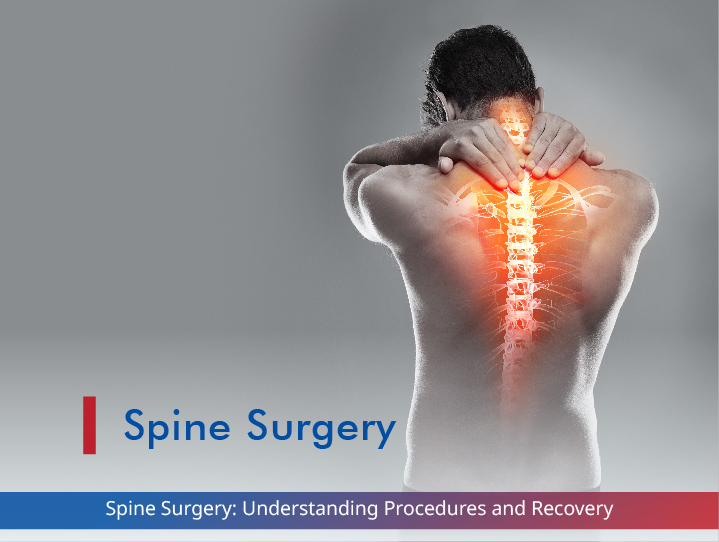Introduction
Spinal fusion surgery is a highly technical procedure that has become increasingly common in treating various spinal disorders. This surgical technique permanently connects two or more vertebrae in the spine, eliminating motion between them. As a significant intervention, spinal fusion is considered when other conservative treatment modalities have failed to provide relief. This article delves into the intricacies of spinal fusion surgery, exploring its purposes, procedures, and outcomes.
What is Spinal Fusion Surgery?
Spinal fusion surgery is a procedure designed to join two or more vertebrae in the spine, creating a solid bone unit. This fusion process mimics the normal healing of a broken bone, where separate pieces fuse into one. During the spinal fusion surgery, a surgeon places bone or bone-like material between the vertebrae. Often, metal plates, screws, or rods are used to hold the vertebrae together, allowing them to heal into a single, solid bone.
When is Spinal Fusion Needed?
The doctors generally recommend the spinal fusion procedure for various conditions affecting the spine, such as:
- Degenerative Disc Disease: When spinal discs break down due to natural wear and tear, causing instability and pain.
- Spinal Stenosis: This condition manifests as spinal canal narrowing, which can put pressure on nerves.
- Spondylolisthesis: A disease where one vertebra slips forward over another.
- Scoliosis: Abnormal curvature of the spine.
- Spinal Fractures: Especially those causing instability or neurological issues.
- Spinal Tumours: When tumours affect spinal stability.
- Severe Chronic Back Pain: Doctors recommend spinal fusion for back pain when other conservative treatments have failed to provide relief.
Types of Spinal Fusion
Several types of spinal fusion surgeries exist, varying based on the approach and specific technique:
- Anterior Lumbar Interbody Fusion (ALIF): Approach through the abdomen. ALIF is commonly used for lower back conditions, such as spondylolisthesis and degenerative disc diseases.
- Posterior Lumbar Interbody Fusion (PLIF): Approach from the back. Doctors may perform PLIF procedures to treat degenerative disc diseases, spinal instabilities, and herniated discs.
- Transforaminal Lumbar Interbody Fusion (TLIF): Similar to PLIF but with a more lateral approach. A TLIF treats spine conditions in the lumber spine area, such as degenerative disc diseases, recurrent disc herniation, or spinal instabilities.
- Lateral Lumbar Interbody Fusion (LLIF): Approach from the side. This technique is suitable for all degenerative conditions.
- Cervical Fusion: For the neck region of the spine. Doctors generally indicate this procedure in herniated discs, degenerative disc disease, and other problems in the neck.
The final surgical approach to be employed depends on the specific condition, location of the problem, and the surgeon’s expertise.
Benefits of Spinal Fusion Surgery
The spinal fusion procedure offers several potential benefits:
- Pain Relief: By stabilizing the spine, spinal fusion surgery can significantly reduce chronic back pain.
- Improved Stability: Enhances spinal stability in conditions like spondylolisthesis.
- Deformity Correction: Effective in treating spinal deformities like scoliosis.
- Neurological Function Improvement: Can alleviate pressure on nerves, improving symptoms like numbness or weakness.
- Quality of Life Enhancement: Successful fusion can improve mobility and daily functioning.
Spinal Fusion Risks and Potential Complications
As with any major surgery, spinal fusion carries some risks, such as:
- Infection: At the incision site or deeper within the spine.
- Bleeding and Blood Clots: Potential for excessive bleeding or clot formation.
- Nerve Damage: Risk of injury to spinal nerves.
- Hardware Failure: Possibility of implants breaking or loosening.
- Pseudarthrosis: Failure of the bones to fuse correctly.
- Adjacent Segment Disease: Increased stress on vertebrae above and below the fusion.
Alternatives to Spinal Fusion Surgery
Before opting for spinal fusion, several alternatives might be considered:
- Physical Therapy: Physiotherapy helps strengthen core muscles and improve flexibility.
- Pain Management: Including medications and injections.
- Minimally Invasive Procedures: Such as microdiscectomy for herniated discs
- Artificial Disc Replacement: An alternative for some degenerative disc conditions
Recovery After Spinal Fusion
Recovery from spinal fusion surgery is a gradual process:
- Hospital Stay: Typically 2-4 days post-surgery, but it could be longer for more extensive surgical procedures.
- Initial Spinal Fusion Recovery: Limited mobility for a few initial weeks, with a gradual increase in activities
- Physical Therapy: Crucial for regaining strength and flexibility.
- Pain Management: Medications (IV or oral) and techniques to manage post-operative pain.
- Bracing: Often required for several weeks to support the spine.
- Return to Work: Usually possible within 4-6 weeks for sedentary jobs, longer for physical jobs.
- Full Recovery: Complete fusion and recovery can take 6-12 months.
Success Rates and Long-term Outlook
The success of spinal fusion surgery varies and depends on the ailment treated and individual factors:
- Pain Relief: Many patients experience a reduction in back pain.
- Fusion Rates: Rates are generally high, with modern techniques achieving fusion in 90-95% of cases.
- Functional Improvement: Most patients see improved mobility and quality of life.
- Long-term Outcomes: Generally good, but adjacent segment disease can occur over time.
- Lifestyle Adjustments: Some lifestyle modifications are necessary to maintain spinal health post-fusion.
Conclusion
Spinal fusion surgery is a significant medical intervention that can provide relief and improved function for those suffering from various spinal conditions. While it carries risks and requires a substantial recovery period, it offers a path to reduced pain & improved quality of life for many patients. The decision to have a spinal fusion should be made carefully, in consultation with a qualified spinal fusion surgeon, considering all available options and potential outcomes.
FAQs
Can you live a normal life after a spinal fusion?
Yes, most patients can return to a normal lifestyle after spinal fusion. While they may encounter some limitations in flexibility, many people experience considerable relief from pain and improved function. Adapting to the changes and following post-operative guidelines are key to a successful outcome.
How serious is back fusion surgery?
Spinal fusion is considered a major surgery. It involves risks, including infection, nerve damage, and implant failure. However, with modern surgical techniques and proper patient selection, it’s generally safe and effective when performed by experienced surgeons.
What is the recovery time for spinal fusion surgery?
Individual recovery times can vary based on the specific procedure, overall health, and adherence to post-operative care instructions, but generally:
- Hospital stay: 2-4 days
- Initial recovery: 4-6 weeks of limited activity
- Return to sedentary work: 4-6 weeks
- Return to more physical activities: 3-6 months
- Complete fusion and recovery: 6-12 months


















